
The Nature of Water Resource Conflict
Game Theory: A Brief Introduction
Water Resources and Conflict:
Game Theory
Kristina Schneider
CE 384D
With the ever increasing population on this planet the resources we have will become more strained. Many resource-based conflicts have been focused on oil and other technologically - replaceable resources. However, water is a basic resource that is necessary for the production of both fuel and food. It is used for waste disposal, industrial practices, and transportation. Ismail Serageldin, vice-president of the World Bank stated in a 1995 New York Times article that " The wars of the next century will be about water." Therefore, it is important to understand the nature of water resource conflict and that it is such a threat to our worlds security. One goal of this report is to give a brief description of these types of conflict to the reader so they may have a better understanding of the issue at hand.
In addition to understanding the nature of international water resource conflict, methods must be developed to aid in the resolution of these conflicts. Many tools are available to aid in conflict resolution and one option is Game Theory. This method treats the parties of a negotiation as players and attempts to determine the optimal solution to their conflict by treating it as a game. This theory has been used quite effectively in the business world as well as in the social sciences. In a few select cases, game theory has been used to determine solutions to water resource conflicts. One goal of this project is to apply game theory to an international conflict. The Syr Darya River basin in Central Asia was selected to model since it fulfills many roles in the region. The river feeds the Aral Sea and is one of the major sources of water in the region. In addition, it is used to generate hydropower to heat the homes in the winter of residents of the upstream nations. By exploring the two goals of this report, an understanding of the nature of international water resource conflict and a possible tool that may aid in the resolution of these problems will be gained.
The Nature of Water Resource Conflict
Our sources of fresh water are not contained in the political boundaries that we have created, they naturally flow as the landscape dictates. Some regions of the world have water to waste, where others depend on every last drop. Water is hard to distribute from of plenty to those of scarcity. However in both regions of water wealth and water scarcity, conflict may arise when two or more nations vie for a water body's limited supply.As countries progress technologically, the amount of water that is desired and used by its population increases (Gleick, 1993). At some point these countries will reach the limit of their resources and it is possible that the limit of their industrial development will also be reached. The factors which determine the speed at which these boundaries are reached include the absolute availability of water, the level of development desired, and the population supplied. In addition, the quality of the water available is another factor that must be addressed when considering water availability. Water is worthless if its quality makes it unusable. Water must be available in sufficient quantities and quality levels.
Once a water resource conflict arises, it may be based on the actual water body, i.e. the amount of water that is present, and/or the effects from water development projects, such as dams and reservoirs. When the concern is about the amount of water present, there are several factors that may lead to water resource rivalry. These include the degree of scarcity of water, the extent the water supply is shared among countries, the relative power of each of the states, and the accessibility of alternate fresh water supplies (Gleick, 1993). Of course other sociopolitical factors, such as economic competition, ideological differences, and border arguments, increase or perpetuate resource based conflicts. Conflicts may also arise from the construction of a dam or reservoirs. Major development projects greatly alter the hydrologic and ecological attributes of a water body system, and may displace large populations and change the way local resources are accessible.
Finally, one important question is will a water resource conflict lead to violent conflict? Multiple sources maintain violence will most likely not be a factor in water disputes. Wolf (2001) states that war over water is neither strategically rational, hydrographically effective, or economically viable. Why would an attack be launched over water? A weak upstream nation might have reason to launch an attack against a strong downstream aggressor but this would be foolhardy since they would most likely lose. A strong upstream nation would have no need to attack because they control the water below. If a downstream nation attacked an upstream aggressor if the issue was a dam, a dam break would wipe out the downstream nation. Also, the nations would not be democratic since, political science maintains democracies do not attach each other. Strategically, war over water is not likely. Hydrologically, nothing is gained by going to war over water and economically it is probably cheaper to convert seawater to freshwater than go to war. Of course, even if violent conflict is not the outcome of resource inequalities, they will lead to shortened lives and more poverty (Gleick, 1993).
Game Theory: A Brief Introduction
Game theory is a branch of mathematics that emerged in the middle of the last century. It would be better called the theory of Conflict Resolution. It describes the manner in which two or more decision makers strategize and make choices in a possible conflict situations. Therefore, two person or multi-person games exist and decision makers are called players. The complications involved in the game increase with the number of players.In addition, since game theory is a form of mathematics there are many theorems that dictate the selection of a solution to a game.
There are certain assumptions that accompany game theory. It is thought each player can decide between two or more clear choices, called strategic choices. Every decision a player can make will lead to either a win, a loss, or a draw of the game and these moves will have a payoff associated with them. Also, the rules of the game and the payoffs for each player are known to all participants in the game. Finally, it is assumed the players will act rationally, choosing the payoff that is the greatest. The optimal solution can then be determined. Of course, in the real world decision makers often do not have full knowledge of a situation or always act rationally. Even with these drawbacks, game theory can be very useful.
The payoffs of the game are the determining factors in the decision making process. A matrix is used to represent payoffs to each of the players for each strategy and allows for the evaluation of the payoffs. The payoffs, also, determine the type of game that is played. If the sum of the payoffs equal zero then the players have opposing interests. One player wins while the other player loses and there is a universally accepted solution to the problem. Non-zero-sum games general represent more real life situations that have more complications in the decision making process. The payoffs in a non-zero-sum game do not sum up to zero and therefore they do not have straight forward solutions. It can be said that zero-sum games lay on the end of one continuum and non-zero-games lay on the other. To summarize, games are described by the number of players and the sum of the payoffs. There are two-person zero-sum games, two-person non-zero-sum games, and n-person versions of both.
Application of Game Theory to the Syr Darya River Basin
The Syr Darya River Basin is located in Central Asia and drains into the Aral Sea. With the deterioration of the quality and the quantity of water in the sea, much study has been done on this river basin. The Syr Darya flows through Kazakhstan, Kyrgyzstan , Turkmenistan, Tajikistan, and Uzbekistan. In the map below, the river has been highlighted by the bright blue line.
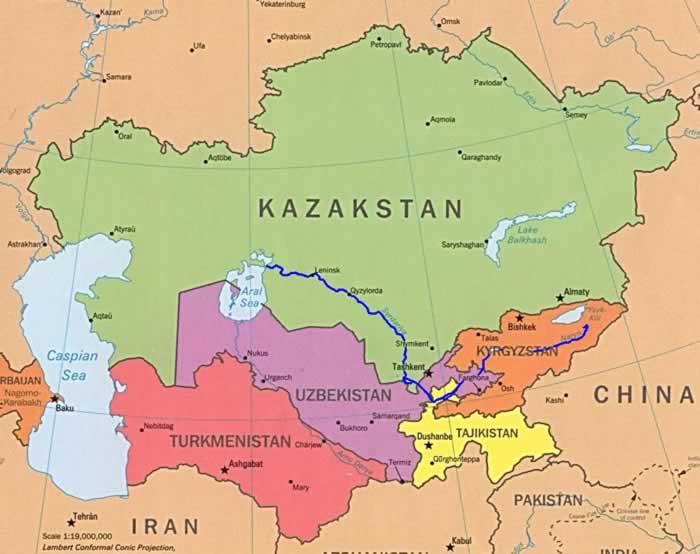
This river basin faces unique challenges stemming from its prior inclusion in the Soviet Republic. Water resource allocation schemas were developed with the following assumptions: the river basin was contained in one country, the hydro-technical facilities were developed to serve irrigation, water deficits would be alleviated by inter-basin transfers from other Soviet Republics, and upstream countries receive winter time heating fuels from the downstream nations (Keith and McKinney, 1997).
One of the largest and most important reservoirs in the basin is Toktogul Reservoir, which is located near the border of Kyrgyzstan and Uzbekistan. The picture below shows a view of the reservoir. Toktogul is part of the Naryn-Syr Darya Cascade, along with four other constant volume hydropower facilities. The reservoir is used by the Kyrgyz Republic for the production of power and the downstream countries use the storage available to irrigate their crops in the summer months. While the USSR existed the available storage was solely used to satisfy irrigation demands of the downstream countries. In the winter fossil fuels were shipped in to Kyrgyzstan to supplement energy production.
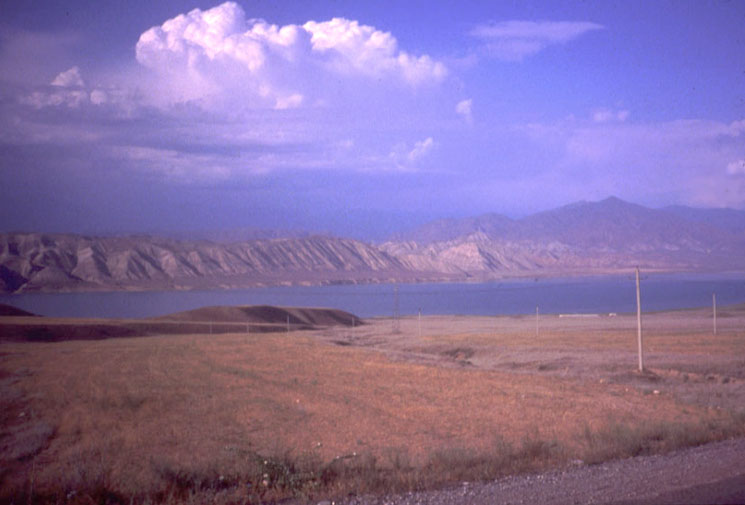
When the USSR disintegrated, the republics decided to continue to abide by water allocations made in 1982. However, Toktogul is owned solely by the Kyrgyz Republic and in 1991 the operating plan was changed to allow for power production in the winter since fuel deliveries had been suspended from the downstream nations. Kazakhstan and Uzbekistan are the two downstream countries that are concerned about the releases from the reservoir since their economies rely heavily on irrigated agriculture. Since 1991, Kazakhstan, Kyrgyzstan, and Uzbekistan have been in negotiations concerning the operation scheme of the Toktogul Reservoir. Agreements have been reached that satisfy the Kyrgyz's need for electricity and the downstream nations' summer water needs. The Kyrgyz Republic reserves some storage for the summer months while Uzbekistan and Kazakhstan provide fossil fuels for the winter months. The table below details the release agreement.
Table 1. Agreed Releases from the Toktogul Reservoir

The releases designated by the exchange agreements are based on historical flows. In all but one month in the years 1988 - 1997 the natural flows of the rivers would have met the requested releases. The new implementation schema, in place since 1991, the releases during the summer months have decreased from 8.5 km3 to 6.5 km3 in conjunction with the plan. The winter releases have increased approximately 5 km3. The total annual release from the reservoir has increased from 12.5 km3 to 14.5 km3 and this has reduced the active storage of the reservoir from 12.5 km3 in June of 1994 to 5.5 km3 in June of 1997. Certain years the downstream nations have not sent their specified amounts of fuel and the reservoir had to be used to power production. These releases reduced the amount of water available for irrigation in the summer season. Clearly, the agreements reached at this time were not the optimal solutions for both parties (McKinney, 1997).
An analysis of different management options would be helpful to determine the possible solutions to the Toktogul Reservoir issues. The Multiobjective Water Resource Allocation Model for the Toktogul Reservoir was developed for this purpose (McKinney and Cai, 1996). It was decided to use the results of this model in the creations of a game theory setting for the Syr Darya basin. The model calculates deficits of water for irrigation in Kazakhstan and Uzbekistan as well as the power delivered to the Kyrgyz Republic for three scenarios. The scenarios are as follows:
-
The Toktogul Reservoir is operated to maximize irrigation needs.
-
Power generation is maximized to meet the Kyrgyz Republic needs in the summer and winter.
-
A baseline that calculates the irrigation water available if the dam was not present.
As for any model certain assumptions are made and constraints exist. The model is constrained by data that was made available to the Environmental Policy and Technology Project of the USID, that sponsored the model application, and other constraints suggested by the water and power ministries of the countries in question. The assumptions are as follows: a five year modeling period, the minimum inflow to the Aral Sea is 1.35 km3/yr, and the initial volume of the reservoirs are at the maximum. To model the stochastic nature of meteorological cycle, two flow sequences were chosen. The first solution uses a flow sequence in which the flow is normal (30.63 km3) for the 5 year modeling period. The second sequence inserts a very dry year (21.1 km3) in the middle of four normal flow years (McKinney, 1997).
The model calculated the water deficit in the Syr Darya as well as the deficit of power in the Kyrgyz Republic for each of the scenarios and flow sequences. The power was given in units of GWh/yr and the deficit in km3/yr. To allow for an easier comparison of the two factors, they were converted into millions of dollars. The water deficit was converted based on the value of irrigation per hectare and the value of the power was calculated based on the market prices for power during the summer and the winter. For the net margin of the irrigation benefits a range of deficits were given, this was due to the data that was available to run the model. Two sources of cropping patterns, which were used to calculate the irrigation/ha, were given as Burns and Roe/Haza Assessment of the Export Market for Kambarata Electricity (1996) and Volumes II - V of the TACIS Phase I Report (1995). Since these sources produced a large range of values, the Burns and Roe is viewed as a maximum deficit and the TACIS as a minimum deficit. The value of the net power was calculated for a fixed cost scenario and peak price scenario. It was found the price during peak period is 4.45 cents/kWh and 2.5 cents/kWh for off peak period and the fixed cost scenario. The table below shows some of the results calculated.
Table 2. Appended Values Based on Water Requirements and Net Margins per Hectare

One goals for this project is to apply game theory to the conflict situation in the Syr Darya Basin. The optimal solutions that were determined by the Multiobjective Water Resource Allocation Model for the Toktogul Reservoir are used to create various payoff matrices, which are a method to order the strategies and values of the possible outcomes. An evaluation of these matrices will aid in the determination of an optimal solution.
A two-person non-zero-sum type game was chosen to represent the Syr Darya conflict. The two players in the game are the upstream countries and the downstream countries. The upstream countries are actually just Kyrgyzstan and the downstream countries are Kazakhstan and Uzbekistan. Since the main goal of Uzbekistan and Kazakhstan is to gain larger amounts of flow for the summer, it is a fair assumption to bulk them together. The simplification of choosing a two person game was applied since n-person games take into account subtleties that are harder to analyze. The game is a non-zero-sum game because the gains of one players are not the full losses of the other player. If Kyrgyzstan releases some water during the winter for power, water may still be released during the summer for irrigational uses. Also if power generated by summer releases can be sold to downstream countries the profits can be used to purchase winter heating fuels, limiting the amount released in the winter.
To create the payoff matrices for the different scenarios, irrigation and power values had to be considered. Matrices were only created for the NNDNN scenario because this is the worst case scenario for both parties. An analysis of the NNNNN would be valid but would not take into account the deficiency in the system caused by a dry year. A matrix was prepared for each combination of irrigation values and power prices. The payoff matrices are shown below with the pure-strategy outcomes. The first value in the brackets are the payoffs to the downstream nations and the upstream payoffs are the second values. All values are in millions of US dollars.
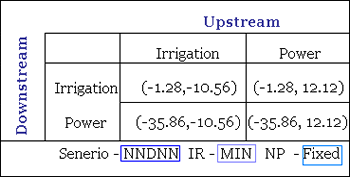
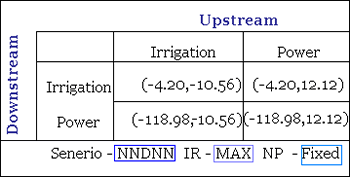

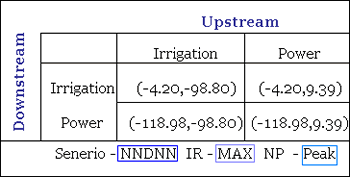
The solution of the matrices will be at the equilibrium point, the stable outcome of a game associated with a pair of strategies. It was thought that equilibria did not exist in non-zero-sum games but John Nash proved in 1950 that they do exist. Therefore, in non-zero-sum games equilibria are called Nash equilibria. Sometimes the equilibrium point is not the best solution for both parties and another option is available. In these cases a Pareto optimal can be determined. The Pareto optimal is an outcome to which no other obviously inferior outcomes exist.
To better visualize a game a payoff polygon, in which the pure-strategy points are the vertices and Pareto optimal solutions are located along the northeast corner of the polygon, can be drawn. The payoff polygons were drawn only for the extreme cases of IR-MAX NP-Peak and IR-MIN NP-Fixed and they are located below. The value PI was not included in the polygons since it is clearly not a solution. The Pareto optimal solutions are located on the pink and blue lines.

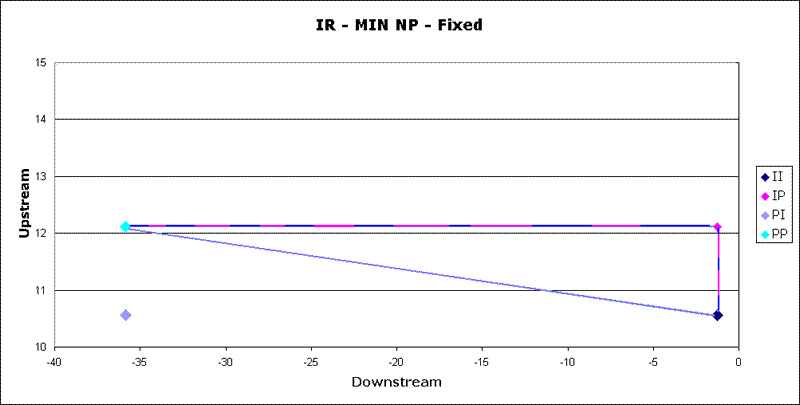
After studying the payoff matrices and polygons created using the economic output of the Multiobjective Water Resource Allocation Model for the Toktogul Reservoir, it is clear that the payoffs are not the outcomes needed to correctly analyze the situation. The model calculates only the responses for the parties to either II or PP solution. By introducing the variables of MAX and MIN irrigation deficit as well as fixed and peak price values, a correct analysis of the situation becomes more complicated since it is not 100% clear which variable is the most valid.
However, these problems were ignored to allow for an analysis of the games proposed. The solution to the game is quite simple. It can been seen in both the matrices and payoff polygons for all matrices that the Nash equilibrium is the IP solution. The outcomes for both players is at maximum for this solution. Of course, this is a logical answer to the conflict since the downstream nations would prefer an irrigation schema and the upstream nation would like to optimize power production. In reality, this solution is not valid but if the values were real this would be the solution to the game.
International Water Resources Conflicts will occur in future because clean water resources are limited and use is increasing. Additionally, rivers flow across political boundaries man has made. International river and lake basins cover almost 50% of the world's continental land area (United Nations, 1978). Violent conflict is not a likely outcome of resource disparities but solutions must be found to deal with conflicts that do arise. Therefore, it is vital to understand the tools that exist to aid in the complicated decision making that must take place during the conflict resolution.
Game theory was explored as a tool in international water resource decision making. The Syr Darya river basin was taken as an example situations. The solutions from the Multiobjective Water Resource Allocation Model for the Toktogul Reservoir were used to create the payoff matrices and polygons for the conflict. The nations of Kazakhstan and Uzbekistan were chosen to be the downstream players and Kyrgyzstan was the upstream player. Examination of the data available from this model found the data was not in the correct format to correctly apply the game theory. Game theory is a valid tool in the determining of optimal solutions in resource conflicts and it should be explored to a greater extent.
References
Antipova,E. A. Zyryanov, D. McKinney, A. Savitsky , Optimization of Syr Darya Water and Energy Uses, Water International, Submitted 2001
Davis, M., Game Theory: A Nontechnical Introduction, Basic Books, Inc., New York, 1983.
Gleick, P., "Water and Conflict: Fresh Water Resources and International Security," International Security, Vol. 18, No. 1, 79-112, 1993.
Gleick, P., ed., Water in Crisis: A Guide to the World's Fresh Water Resources, Oxford University Press, New York, 1993.
Keith, J., and D. McKinney, "Options Analysis of the Operation of the Toktogul Reservoir", USAID Environmental Policy and Technology (EPT) Issue Paper, No. 7, Almaty, Kazakhstan, August, 1997.
McKinney, D. "Optimization of Water Use: The Naryn-Syr Darya Cascade", USAID Environmental Policy and Technology (EPT) Issue Paper, No. 7, Almaty, Kazakhstan, January, 1997.
McKinney, D.C. and X. Cai, "Multiobjective Optimization Model for Water Allocation in the Aral Sea Basin", Proc. 3-rd Joint AIH/CIS Conference, Tashkent, 1996.
Straffin, P., Game Theory and Strategy, The Mathematical Association of America, Washington, D.C., 1993.
United Nations, Register of International Rivers, Pergamon Press, Oxford, U.K., 1978.
Wolf, A., "Water and Human Security," Water Resources Update, No. 118, 29 - 37, 2001.
Web Pages
Environmental links: http://members.tripod.com/jmthurman/atraf- muhit/envlnks.html
Regional Cooperation in Managing Scarce Resources: http://www-esd.worldbank.org/rdv/training/dinar/regncoop.htm
Convention on the Protection and Use of Transboundary Watercourses and International Lakes: http://www.unece.org/env/water/
International Water and Sanitation Centre: http://www.irc.nl/index.html
Aral Sea Basin Network: http://www.aral-sea.net/
Special Thanks
Dr. McKinney, University of Texas at Austin
My Editor